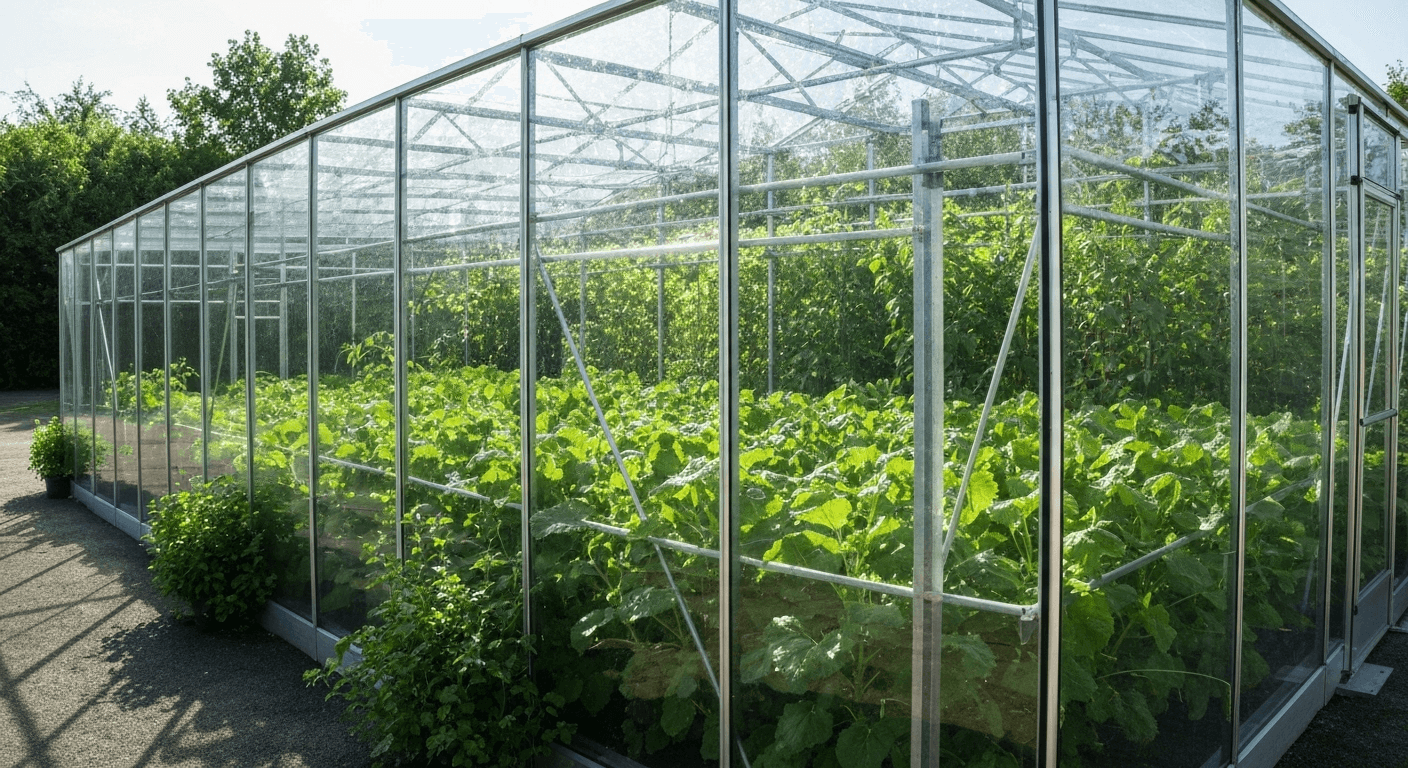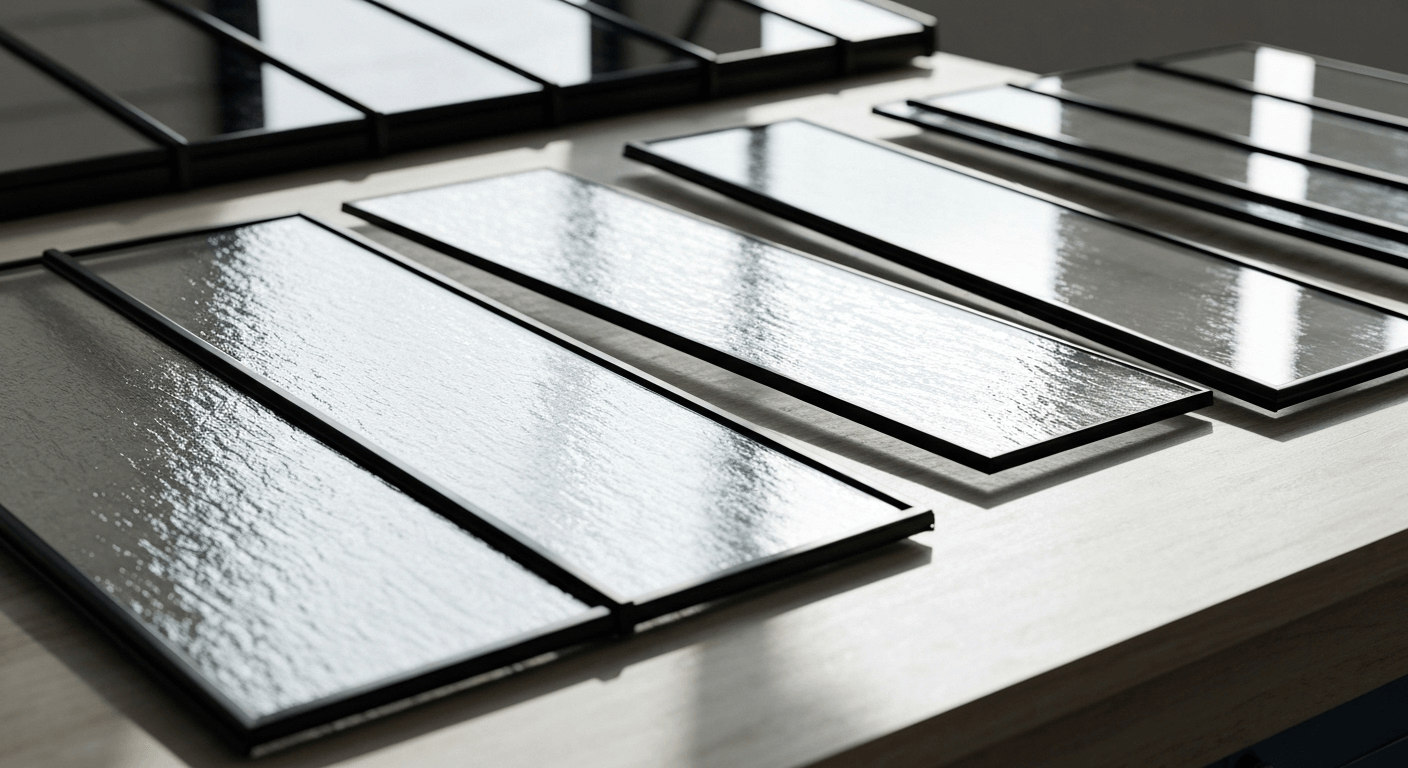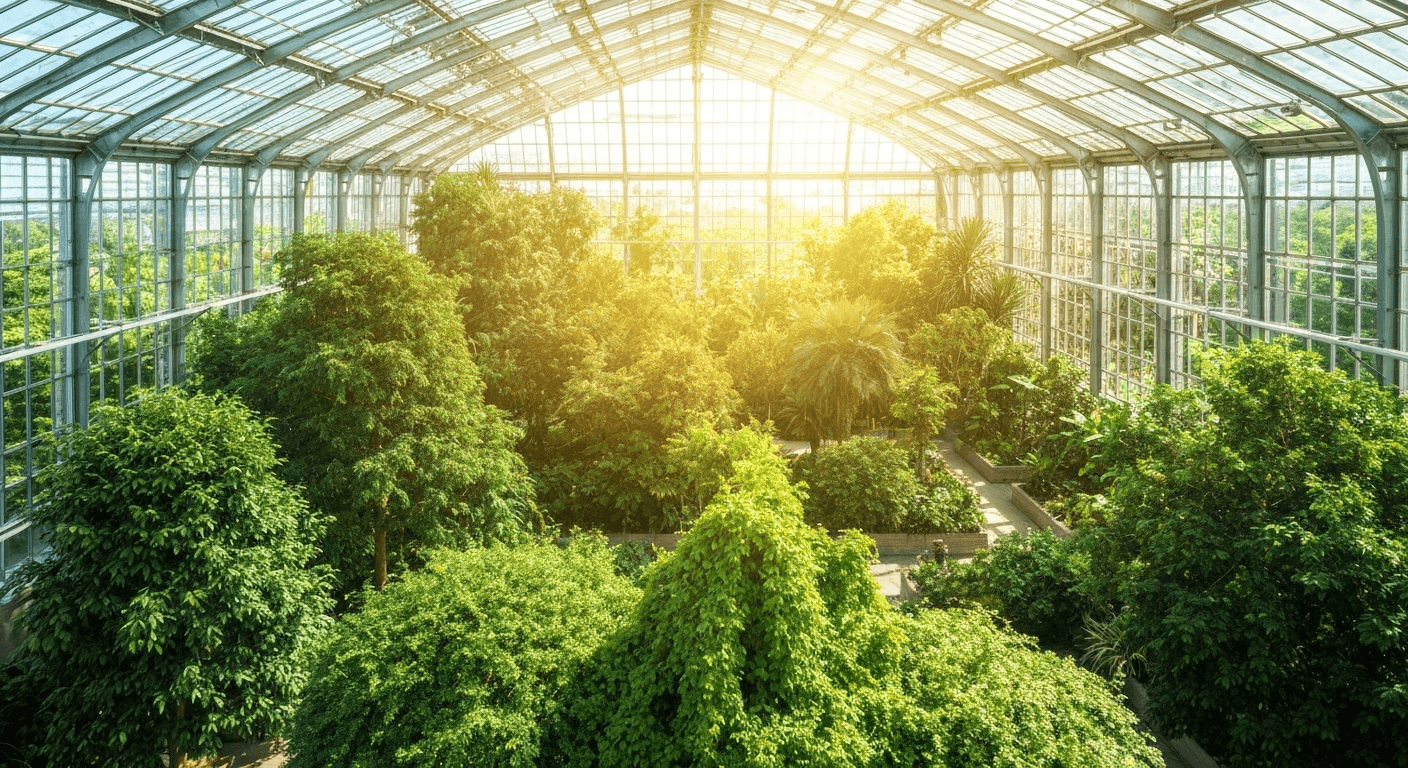Greenhouse Glass Panels: Pros and Cons You Should Know
发布时间:
2025-10-10 11:59
来源:
huizeglass
Key Highlights
- Choosing the right greenhouse glass panels is crucial for optimal plant growth and a durable structure.
- Tempered glass offers superior strength and safety, making it a top choice over standard glass.
- Different glass types, like insulated and laminated glass, provide unique benefits for temperature control and UV protection.
- Energy efficiency is a major advantage of glass, especially with double-pane options that reduce heating costs.
- While polycarbonate panels are an alternative, glass provides better light transmission and longevity.
- Your specific climate and budget will help determine the best type of glass for your needs.
Introduction
Welcome to the world of greenhouses, where you can create the perfect environment for your plants to flourish all year. The success of your greenhouse heavily depends on the materials you choose, especially the glazing. The right glass panels can significantly impact light transmission, temperature stability, and overall plant growth. This guide will walk you through the pros and cons of different options, helping you select the best glass for a beautiful and productive greenhouse design.
Overview of Greenhouse Glass Panels

When it comes to greenhouse glazing, glass remains a classic and highly effective choice. There are several different glass types available, each with its own set of advantages and disadvantages. From basic float glass to high-performance insulated panels, the options can seem overwhelming.
Understanding these choices is the first step toward building a greenhouse that meets your specific needs. This overview will introduce you to the common types of greenhouse glass panels so you can make an informed decision for your gardening projects.
What Are Greenhouse Glass Panels?
Greenhouse glass panels are specialized panes of glass designed to create a controlled environment for growing plants. Unlike the standard glass you might find in a home window, greenhouse glass is selected for properties like light transmission, durability, and insulation. The goal is to let in maximum sunlight while protecting plants from harsh weather.
The type of glass used can vary greatly. The manufacturing process determines its strength and safety features. For example, tempered glass is heat-treated to be much stronger than regular glass, while laminated glass includes a plastic layer for added safety.
Ultimately, these glass panes form the walls and roof of your greenhouse. The choice you make will directly affect how well your plants grow, how much you spend on heating, and how long your structure lasts.
Why Choose Glass for Your Greenhouse?
Choosing glass for your greenhouse covering offers several distinct advantages over plastic alternatives. Glass provides unmatched clarity and allows for maximum natural light penetration, which is essential for healthy plant growth and photosynthesis. Plus, its classic look adds a timeless visual appeal to any garden.
Unlike some plastics that can yellow or become brittle over time, glass maintains its transparency and durability for decades. This longevity makes it a great long-term investment. Key benefits include:
- Superior Light Transmission: Glass allows 80-90% of sunlight to pass through, boosting plant health.
- Durability: It resists scratches and won't degrade from UV exposure like plastic can.
- Improved Energy Efficiency: Options like insulated glass help maintain stable temperatures and lower heating costs.
How do I choose the right type of glass panels for my greenhouse? Your choice should depend on your climate, budget, and the types of plants you plan to grow. If you live in a cold region, insulated glass is a wise choice. For areas with a risk of hail or high winds, tempered glass offers the best durability.
Common Types of Greenhouse Glass Panels

There are several common types of glass used for greenhouse glass panels, and each serves a different purpose. Your choice will depend on factors like your climate, safety concerns, and budget. The main options include float glass, tempered glass, laminated glass, and insulated glass.
Understanding the differences between these materials is key to building a greenhouse that meets your specific requirements. In the following sections, we will explore the pros and cons of each to help you decide which is the right fit for your gardening needs.
Float Glass vs. Tempered Glass
Float glass, often called regular glass, is the most basic and affordable option. While it offers good light transmission, its biggest drawback is its fragility. When float glass breaks, it shatters into large, dangerous shards, posing a significant risk of injury.
Tempered glass, on the other hand, is a type of safety glass. It is heat-treated to be four to five times stronger than float glass. If it does break, it crumbles into small, dull-edged pieces, making it a much safer choice for greenhouses, especially in areas with children, pets, or harsh weather. What's the difference in price and durability between tempered and laminated greenhouse glass? Tempered glass is more durable against direct impact than laminated glass, but laminated glass offers better security and UV protection. Tempered is often less expensive than laminated glass.
| Feature | Float Glass | Tempered Glass |
|---|---|---|
| Strength | Low | High (4-5x stronger than float) |
| Safety | Poor (breaks into large shards) | Excellent (crumbles into small, dull pieces) |
| Durability | Low | High |
| Cost | Low | Moderate |
Laminated Glass for Added Safety
Laminated glass is another excellent safety glass option for greenhouses. It is made by bonding two or more layers of glass together with a durable plastic interlayer, typically polyvinyl butyral (PVB). This construction gives it unique safety properties.
The main benefit of laminated glass is that when it glass breaks, the fragments stick to the plastic interlayer instead of scattering. This drastically reduces the risk of injury and helps the panel remain in its frame, offering continued protection from the elements even after being damaged.
Are laminated glass panels a good choice for greenhouses? Yes, they are a fantastic choice, especially in areas prone to severe weather or where security is a concern. They also offer the added benefit of blocking up to 99% of harmful UV rays, protecting both you and your plants.
Insulated Glass and Double-Pane Solutions
For gardeners in colder climates, insulated glass is one of the best glass choices for maximizing energy efficiency. Also known as double-pane glass, this solution consists of two panes of glass separated by an air gap. This gap is often filled with an inert gas like argon to further enhance its insulating properties.
This design dramatically reduces heat transfer, keeping your greenhouse warmer in the winter and cooler in the summer. By minimizing heat loss, insulated glass can significantly lower your heating costs and create a more stable growing environment for your plants. It's a top-tier option among greenhouse glazing options.
Do glass greenhouse panels provide better insulation than plastic alternatives? High-quality insulated glass panels can offer insulation comparable to or even better than some multi-wall polycarbonate panels. They can cut heat loss by up to 50% compared to single-pane glass, making them a superior choice for year-round growing.
Key Benefits of Using Greenhouse Glass Panels

Using greenhouse glass panels comes with a host of benefits that make them a popular choice for gardeners everywhere. Beyond just looking great, glass provides an optimal environment for plant growth by offering superior light transmission. The right glass can also lead to significant energy savings.
The combination of longevity, aesthetic appeal, and performance makes glass the right choice for many. In the next sections, we'll explore these advantages in more detail, from light quality to temperature control.
Superior Light Transmission for Plant Growth
One of the greatest advantages of glass is its superior light transmission. Healthy plant growth depends on receiving ample sunlight for photosynthesis, and glass is unparalleled in its ability to let light shine through. Most glass panels offer excellent light transmission, with some high-quality options allowing up to 97% of natural light to reach your plants.
How do glass panels benefit plant growth compared to other options? Unlike plastic panels, which can degrade and become cloudy over time, glass maintains its clarity for decades. This ensures your plants consistently receive the high-quality light they need to thrive. Consistent and unfiltered direct sunlight is incredibly beneficial for plant health.
Key light-related benefits include:
- Maximized Photosynthesis: More light leads to stronger, healthier plants and higher yields.
- Full-Spectrum Light: Glass allows a broad spectrum of light to pass through, which is vital for all stages of plant development.
- Long-Term Clarity: Glass does not yellow or haze, guaranteeing consistent light levels for years.
Visual Appeal and Longevity
A glass greenhouse is more than just a functional growing space; it’s a beautiful garden feature. The crystal-clear look of glass adds a touch of elegance and sophistication to any backyard, enhancing its overall visual appeal. This classic aesthetic is a key reason why many gardeners prefer glass over plastic alternatives in their greenhouse design.
Beyond its looks, glass offers incredible longevity. The right type of glass, such as tempered or laminated glass, is built to last. It can withstand harsh weather conditions, resists scratching, and won't be broken down by UV rays. While other materials may need replacing after a decade, a well-maintained glass greenhouse can last for 25 years or more.
This combination of beauty and durability makes glass a fine choice for anyone looking to make a long-term investment in their garden. It's a structure that you and your plants will enjoy for many years to come.
Temperature Control and Insulation Advantages
Effective temperature control is essential for a successful greenhouse, and glass offers excellent insulation properties. Different glass types contribute to energy efficiency in various ways. Single-pane glass is standard, but double-pane insulated glass provides superior performance by creating a thermal barrier that reduces heat loss.
This improved insulation helps maintain a stable internal temperature, protecting plants from sudden drops at night or in the winter. Better climate control not only leads to healthier plants but also reduces the need for constant heating, which can save you money on energy bills.
Do glass greenhouse panels provide better insulation than plastic alternatives? Yes, when you choose the right type. While basic single-pane glass has less insulation than twin-wall polycarbonate, double-pane insulated glass often outperforms most plastic options. It can reduce heat loss by as much as 50%, making it a premier choice for serious gardeners.
Drawbacks to Consider with Greenhouse Glass Panels
While glass offers many benefits, there are a few drawbacks to keep in mind. The initial cost, potential for breakage, and weight are important factors to consider. Compared to alternatives like polycarbonate panels, glass, especially specialized types, can be more expensive upfront.
Breakage is another concern, particularly with regular glass. Understanding the cost difference and maintenance requirements will help you make a fully informed decision that balances pros and cons. We will discuss these considerations in the following sections.
Initial Costs Compared to Polycarbonate Options
One of the main factors to consider is the total cost. Generally, glass panels have a higher upfront cost than polycarbonate panels. What is the typical cost difference between glass panels and polycarbonate sheets for greenhouses? The exact cost difference depends on the choice of glass. Basic float glass is more affordable, but high-performance options like tempered or insulated glass are a significant investment.
While the initial price is higher, it's important to think long-term. Glass lasts much longer than polycarbonate and doesn't need to be replaced as often, which can make it more cost-effective over the life of the greenhouse. For large-scale commercial greenhouses, this longevity can offset the higher initial expense.
Here is a general cost comparison per square foot: | Material | Approximate Cost (per sq. ft) | |---|---| | Polycarbonate Panels | $4 - $6 | | Float Glass | $7 - $10 | | Tempered Glass | $15 - $20 | | Laminated Glass | $25 - $35 | | Insulated Glass | $40 - $60 |
Durability and Breakage Concerns
Durability is a valid concern when it comes to glass. Standard float glass can break easily from impacts like hail or a stray baseball. However, modern tempered glass panels are incredibly strong and resistant to breakage. They are specifically designed to withstand harsh weather and accidental impacts, making them a reliable choice.
When a tempered panel glass breaks, it shatters into small, harmless pebbles, which is a key safety feature. Are greenhouse glass panels more durable than polycarbonate sheets? It depends on the context. Polycarbonate greenhouses are more resistant to direct impacts and are virtually unbreakable. However, glass offers superior scratch resistance and UV protection without degrading or yellowing over time.
For most situations, especially when using tempered or laminated glass, durability is not a significant issue. The long-term clarity and resistance to wear and tear often make glass a more durable investment over its entire lifespan compared to plastic alternatives.
Maintenance Needs and Cleaning Requirements
What maintenance do glass greenhouse panels require? Fortunately, the maintenance requirements for glass are quite straightforward. The primary task is regular cleaning to ensure maximum light transmission. Dirt, dust, and hard water stains can build up on the glass panes, reducing the amount of sunlight that reaches your plants.
For most cleaning jobs, warm, soapy water and a soft cloth or sponge are all you need. For tougher stains like mineral deposits from hard water, a simple solution of vinegar and water can be effective. It is best to avoid abrasive cleaners that could scratch the glass, especially if it has special coatings.
Keep these simple cleaning tips in mind:
- Clean Seasonally: Wipe down your glass panels at least twice a year, in the spring and fall.
- Use Soft Materials: Always use a soft cloth or squeegee to prevent scratches.
- Address Stains Promptly: Tackle hard water spots or algae growth as soon as you notice them.
Buying and Customizing Greenhouse Glass Panels
Once you've decided that glass is right for you, the next step is buying the panels. It's important to choose a supplier who can meet your specific requirements, whether you need standard sizes or custom-cut glass for a unique design. Finding the best glass involves considering your climate, plant types, and greenhouse structure.
Making an informed decision at this stage ensures your greenhouse will be both beautiful and functional for years to come. The following sections will guide you on what to know before you buy and where to find custom or replacement panels.
How to Buy Greenhouse Glass Panels—What to Know
When you're ready for the buying process, there are a few key things to keep in mind to ensure you get the right greenhouse panels. First, never use regular window glass or standard glass. These are not designed to withstand the temperature fluctuations and weather exposure that a greenhouse endures.
How do I choose the right type of glass panels for my greenhouse? Your choice depends on your specific needs. Consider the type of greenhouse you have or are building, your local climate, and your budget. A professional supplier can help guide you to the best option.
Here are a few things to consider before you purchase:
- Measure Cautiously: Double-check all measurements to ensure a perfect fit and avoid gaps.
- Consider Your Climate: If you live in a cold area, invest in insulated glass. If you face hail or high winds, choose tempered glass.
- Think About the Frame: Ensure your greenhouse frame is strong enough to support the weight of the glass you choose.
Custom-Cut Glass Options for Unique Designs
Do you have a vision for a one-of-a-kind greenhouse? With custom-cut glass, you can bring your unique designs to life. Whether you're building a lean-to greenhouse against a wall with an unusual angle or designing a geodesic dome, standard-sized panels might not work.
Can I get custom-cut glass panels for my greenhouse and where should I order them? Absolutely! Reputable glass suppliers like Huize Glass specialize in providing custom solutions. You can order glass panes cut to your exact specifications, ensuring a perfect fit for any project. This allows you to make the right choice of glass—be it tempered, laminated, or insulated—for your specific design.
Working with a custom supplier gives you the freedom to create a greenhouse that is not only functional but also a true architectural statement. Don't let standard sizes limit your creativity. Contact us at Huize Glass to discuss your custom project today!
Where to Buy Replacement or Custom Greenhouse Panels
Where can I buy replacement glass panels for a greenhouse? Whether a panel breaks or you're upgrading an old structure, finding the right replacement glass is simple. Your best bet is to contact a specialized glass manufacturer or supplier. They can provide the best glass for your needs, whether it's a single pane or a full set of custom panels.
Local glass shops may be an option for standard cuts, but for specialized types like tempered or insulated glass, a dedicated supplier is the way to go. This is especially true if you are a commercial grower with very specific needs for performance and durability. A knowledgeable supplier will ensure you get a product that matches your existing panels perfectly.
For both replacement and custom panels, look no further than a trusted expert. At Huize Glass, we offer a wide range of greenhouse glazing options and can cut panels to your exact requirements. Get in touch with us to find the perfect solution for your project.
Conclusion
In summary, greenhouse glass panels present a unique blend of benefits and challenges. From superior light transmission that supports plant growth to their aesthetic appeal and longevity, these panels can significantly enhance your greenhouse experience. However, it’s essential to be mindful of the initial costs, durability, and maintenance requirements associated with them. By carefully considering these factors, you can make an informed decision that best suits your gardening needs. If you're ready to invest in greenhouse glass panels or need assistance, don’t hesitate to reach out and get quotes for your commercial project today!
Frequently Asked Questions
Are greenhouse glass panels more durable than polycarbonate sheets?
When it comes to durability, it depends on the type of glass. Polycarbonate panels are more resistant to impact, but tempered glass offers superior scratch resistance and won't yellow from UV exposure. Over the long term, high-quality greenhouse glass panels often prove to be a more durable investment.
How do I install glass panels on a greenhouse frame safely?
For safe installation), always wear safety gloves and goggles. Ensure the greenhouse frame is stable and can support the weight of the glass panels. It's best to use safety glass like tempered glass and have a second person to help. For complex projects, consider hiring a professional.
What maintenance do greenhouse glass panels require?
The primary maintenance for glass panels is regular cleaning to maintain light clarity. Use warm, soapy water and a soft cloth to remove dirt. Unlike regular glass, panels with special coatings may require specific cleaning agents, so always check the manufacturer's recommendations.
Related News




